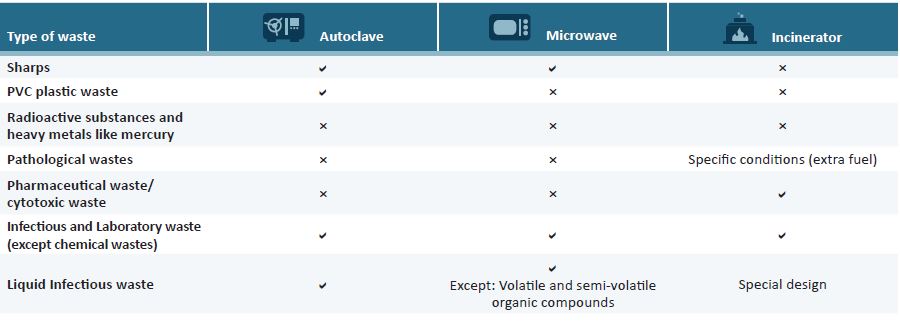Selecting the appropriate medical waste treatment technology is of utmost significance when it comes to ensuring the safety of patients, healthcare workers, and the environment. This blog post emphasizes the importance of making informed choices regarding the technology used for treating medical waste, especially in low- and middle-income countries that may have limited resources.
Understanding medical waste
Medical waste encompasses various categories, such as infectious waste, pathological waste, sharps waste, chemical waste, pharmaceutical waste, cytotoxic waste, and radioactive waste.
Implementing measures to ensure the safe and environmentally responsible management of healthcare waste can prevent adverse health and environmental impacts. It helps to avoid the unintentional release of chemical or biological hazards into the environment, thereby safeguarding the well-being of patients, healthcare workers, and the general public.
In the following sections, we explore different options for medical waste treatment, including environmentally friendly technologies that advance climate mitigation strategies and support global environmental commitments. We also highlight key considerations that aid in making the appropriate choice for procurement.
Technology options
Several treatment technologies exist for medical waste. The following are some commonly employed options:
Low-heat thermal processes
- Steam-based technologies
Commonly used to destroy pathogens contained in infectious and sharp wastes by using thermal energy (heat between 100°C and 180°C). The processes occur in either moist or dry heat environments for a defined period, depending on the load size and the content. The thermal process is commonly performed in an autoclave or steam-based treatment system. - Microwave treatment
An emerging technology that can help solve most waste treatment needs for developing countries. Microwave is essentially moist thermal processes since disinfection occurs through the action of moist heat generated by microwave energy. - Low-heat treatment with mechanical methods
To reduce waste volume, low-heat treatment can be combined with mechanical methods such as shredding, grinding, and compaction. It is important to note that this approach does not eliminate pathogens. However, mechanical methods should not be used for pathological, infectious, and sharp waste before the waste is decontaminated, except if the mechanical process is part of a closed system that decontaminates the chamber of the mechanical process and air before it is released into the surrounding environment. Mechanical methods have the advantage of reducing waste volume, which is made unrecognizable and cannot be reused. However, using mechanical treatment increases the investment and operational and maintenance costs. The decontaminated waste ends up in sanitary landfills.
Burning of waste
- Incineration
Incineration is a dry oxidation process that reduces organic and combustible waste to inorganic, incombustible matter. This method significantly decreases waste volume and weight. However, burning medical waste without appropriate flue gas treatment can release pollutants, including bio-accumulative and toxic substances like dioxins and furans, into the atmosphere.
Information on the type of waste each technology can treat

Each one of the technologies has its advantages and disadvantages. However, autoclaves and microwaves have the upper hand from an environmental or technological point of view. On the other hand, incinerators represent an economical solution.
Efficient waste treatment methods can also aid in volume reduction, minimizing the amount of waste that ends up in landfills. This not only helps conserve space but also prevents potential contamination of soil and water sources.
By prioritizing technologies that minimize pollution of soil, water, and air, healthcare facilities can actively contribute to protecting natural resources and reducing the release of harmful substances into the environment.
Making the Right Choice
The choice of the most appropriate treatment system is linked to the operating context and involves the consideration of critical factors, namely:
- Relevant international and local environmental regulations.
- Characteristics and volume of generated waste.
- Available space and security for the treatment technology.
- Availability of collection and safe disposal of treated waste.
- The use of decentralized or centralized waste treatment instructed by national policy for waste management.
- Budget for capital, operation and maintenance costs.
- Calculation of required treatment capacity.
For the waste treatment plant, the site needs careful consideration. Some utilities should be available to operate medical waste equipment:
- Stable electricity source.
- Demineralized water (for steam generation in autoclaves, and wet scrubbers in incinerators.
- Drainage, and good ventilation to maintain a low-level temperature in the working area.
In conclusion, selecting the right medical waste treatment technology is crucial for ensuring the safe and environmentally sound management of healthcare waste.
Consider factors such as regulatory compliance, waste characteristics and volume, available space and security, collection and disposal systems, decentralized or centralized treatment, budget, and treatment capacity.
Autoclaves, microwaves, and properly designed incinerators are among the viable options, each with its own advantages and disadvantages.
By making informed choices, healthcare facilities in low and middle-income countries can actively contribute to climate mitigation strategies, meet global environmental commitments, and safeguard public health.

